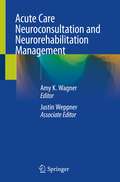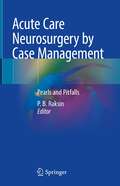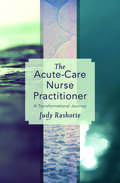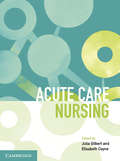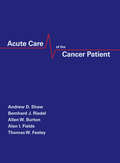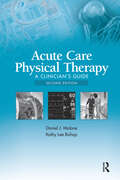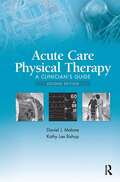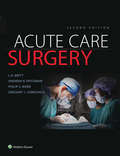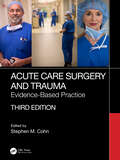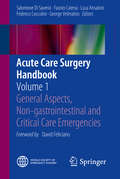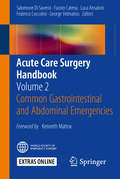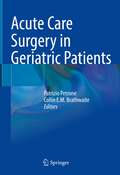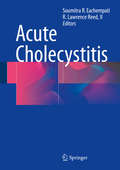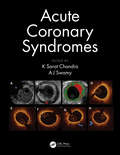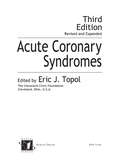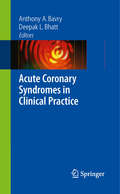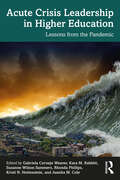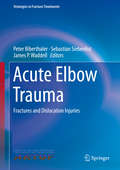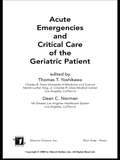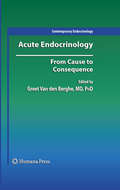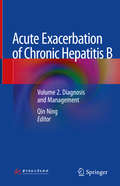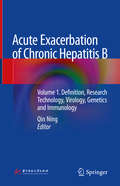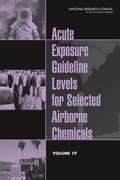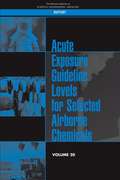- Table View
- List View
Acute Care Neuroconsultation and Neurorehabilitation Management
by Amy K. Wagner Justin WeppnerThis book is a comprehensive resource on acute neurorehabilitation consultations. When a patient first undergoes a traumatic brain or acquired spinal cord injury, an immediate consultation is needed with a rehabilitation specialist. In-depth literature reviews, practice guidelines, and case studies offer in-depth, practical coverage of the complete neurorehabilitation consultation with information on specific testing tools and metrics. The acute care consultant works in concert with other physicians and medical professionals, so throughout the text considerations on how to best organize the team to maximize care is carefully considered. Chapters also explore acute neurological sequelae, including arousal and stimulation, sleep, agitation, spasticity, and seizure prevention, for which an acute care consultant could provide important insight, treatment, and future management recommendations. The book concludes with advice on how to best transition patients from acute to long-term care, including patient prognostication and family education. This is an ideal guide for physiatrists and neurologists aiming to maximize recovery outcomes for their patients.
Acute Care Neurosurgery by Case Management: Pearls and Pitfalls
by P. B. RaksinThis book reviews the common clinical scenarios that might trigger emergent consultation for neurosurgical intervention, with attention to key components of the clinical interview and exam, optimal diagnostic evaluation, indications for and the goals of operative intervention, perioperative considerations, and strategies for complication mitigation. This is not a surgical atlas, but rather, a road map for the journey to the operating room door. The intent is to establish a systematic, evidence-based action plan for the patient presenting in neurologic crisis. Each chapter opens with a relevant case vignette and then unfolds through uniform sections to tell the story of how one might approach the disease entity in question, from initial request for consultation to definitive management, highlighting steps of the decision-making process: • What are the highest yield questions to ask during a focused interview? • What are the most pertinent objective exam findings? • What is the proper differential diagnosis? • What is the most appropriate and efficient plan for diagnostic evaluation – with respect to laboratories and imaging? • Does this patient have an indication for emergent or urgent neurosurgical intervention? • If so, what is the goal of that intervention? • What are the most common potential complications of the proposed procedure, and what steps might be taken to mitigate those risks? Each chapter is punctuated by 3-5 teaching pearls, summarizing these key elements. The overall goal is to create a framework for assessment that might be applied in the emergency department, the trauma bay, or the ICU when a neurologic emergency arises. The scope of the text encompasses not only cranial and spinal trauma, but also entities such as shunt failure, stroke, aneurysmal subarachnoid hemorrhage, pituitary apoplexy, cauda equina syndrome, and central nervous system infection that might require time-sensitive intervention. An additional section addresses issues requiring emergent neurosurgical response in the ICU setting, including sudden neurologic worsening, status epilepticus, and abnormal clotting/ coagulopathy. The text will not only serve as a valuable resource for those preparing to take the oral board exam, but will also provide a targeted refresher for clinicians taking general neurosurgical call in the community as well as an educational reference for mid-level practitioners and those in training who are serving as first responders on behalf of a neurosurgical service.
The Acute-Care Nurse Practitioner: A Transformational Journey
by Judy RashotteFrom the moment it was first proposed, the role of the nurse practitioner has been steeped in controversy. In the fields of both nursing and medicine, the idea that a nurse practitioner can, to some degree, serve as a replacement for the physician has sparked heated debates. Perhaps for that reason, despite the progress of the nurse practitioner movement, NPs have been reluctant to speak about themselves and their work, and their own vision of their role has thus remained largely invisible. Current research is dominated by instrumental and economic modes of discourse and tends to focus on the clinical activities associated with the role. Although information about demographics, educational preparation, position titles, reporting relationships, and costs of care contribute to our understanding, what was missing was an exploration of the lived experience of the nurse practitioner, as a means to deepen that understanding as well as our appreciation for their role. The Acute-Care Nurse Practitioner is based on in-depth interviews with twenty-six nurse practitioners working in acute-care settings within tertiary-care institutions all across Canada. Employing a hermeneutic approach, Rashotte explores the perspectives from which NPs view their reality as they undergo a transformational journey of becoming—a journey that is directed both outward, into the world, and inward, into the self. We learn how, in their struggle to engage in a meaningful practice that fulfills their goals as nurses, their purpose was hindered or achieved. In large part, the story unfolds in the voices of the NPs themselves, but their words are complemented by descriptive passages and excerpts of poetry that construct an animated and powerful commentary on their journey. Poised between two worlds, NPs make a significant contribution to the work of their colleagues and to the care of patients and families. The Acute-Care Nurse Practitioner offers an experiential alternative to conventional discourse surrounding this health care provider’s role.
Acute Care Nursing
by Julia Gilbert Elisabeth CoyneAcute Care Nursing provides an accessible and practical overview of the role of the nurse in acute medical and surgical settings in the Australian and New Zealand context. Linking closely with the Australian 'Registered nurse standards for practice' and the New Zealand Competencies for Registered Nurses, this text equips students with foundational knowledge of the pathophysiology, treatment and legal and ethical issues associated with common acute conditions. Through the person-centred, collaborative care approach, students will also learn effective communication, decision-making and cultural competency skills that are essential for nurses in any practice context. Each chapter is enriched with pedagogical features designed to solidify understanding and promote critical thinking, including case studies, reflections, key terms, review questions, research topics and further readings. Offering students a relevant and contemporary understanding of the acute care context, Acute Care Nursing is an essential companion that can be taken from the classroom into practice.
Acute Care of the Cancer Patient
by Andrew D. Shaw Bernhard J. Riedel Allen W. Burton Alan I. Fields Thomas W. FeeleyDrawing on the real-world experience of leading experts in oncological medicine, this reference serves as an invaluable source of guidance for anyone specializing in the care of acutely ill cancer patients-providing quick reference to effective techniques, therapies, and approaches for surgical, medical, pediatric, pain, and general oncology issues
Acute Care Physical Therapy: A Clinician’s Guide
by Daniel J. Malone Kathy Lee BishopAcutely ill patients are found in the hospital, in the skilled nursing facility, in inpatient rehabilitation facilities, in outpatient practices, and in the home. The role of the physical therapist and physical therapist assistant is to rehabilitate these vulnerable and frail patients to enhance their health and functioning. The goal of Acute Care Physical Therapy: A Clinician’s Guide, Second Edition is to provide the acute care practitioner with the necessary knowledge to improve patients’ structural impairments and activity limitations so they can more successfully participate in life. Nothing could be more challenging and rewarding. Inside, Drs. Daniel Malone and Kathy Lee Bishop, along with their contributors, provide a comprehensive review of acute care physical therapist best practice. This text builds upon fundamental knowledge by addressing important components of the patient examination ranging from the patient’s medical history to laboratory testing to life supporting equipment. Following this introduction, each chapter highlights specific organ systems with a review of pertinent anatomy and physiology followed by common health conditions and medical management. Important physical therapy concerns, examination findings, and rehabilitation interventions are discussed in detail. This Second Edition includes numerous tables, figures, review questions, and case studies that highlight clinical reasoning and the physical therapy patient care model as outlined in the Guide to Physical Therapist Practice. New in the Second Edition: Increased focus on evidence-based examination, evaluation, and intervention The latest technology in physiologic monitoring and patient support equipment Introduces the “PT Examination” and “ICU” algorithms to promote safe and progressive rehabilitation Emphasis on clinical decision making through the application of a clinical reasoning model applied to the end of chapter cases Acute Care Physical Therapy: A Clinician’s Guide, Second Edition will serve as a valuable education tool for students, newer professionals as well as post-professionals who provide therapy services to the acutely ill patient regardless of setting.
Acute Care Physical Therapy: A Clinician's Guide
by Daniel J. Malone Kathy Lee BishopAcutely ill patients are found in the hospital, in the skilled nursing facility, in inpatient rehabilitation facilities, in outpatient practices, and in the home. The role of the physical therapist and physical therapist assistant is to rehabilitate these vulnerable and frail patients to enhance their health and functioning. The goal of Acute Care Physical Therapy: A Clinician’s Guide, Second Edition is to provide the acute care practitioner with the necessary knowledge to improve patients’ structural impairments and activity limitations so they can more successfully participate in life. Nothing could be more challenging and rewarding. Inside, Drs. Daniel Malone and Kathy Lee Bishop, along with their contributors, provide a comprehensive review of acute care physical therapist best practice. This text builds upon fundamental knowledge by addressing important components of the patient examination ranging from the patient’s medical history to laboratory testing to life supporting equipment. Following this introduction, each chapter highlights specific organ systems with a review of pertinent anatomy and physiology followed by common health conditions and medical management. Important physical therapy concerns, examination findings, and rehabilitation interventions are discussed in detail. This Second Edition includes numerous tables, figures, review questions, and case studies that highlight clinical reasoning and the physical therapy patient care model as outlined in the Guide to Physical Therapist Practice.
Acute Care Surgery: Principles And Practice (Spiral Manual Ser.)
by L. D. Britt Andrew B. Peitzman Philip S. Barie Gregory JurkovichPublisher's Note: Products purchased from 3rd Party sellers are not guaranteed by the Publisher for quality, authenticity, or access to any online entitlements included with the product. Substantially updated with more illustrations and brand-new chapters that reflect the growth and advances in the field, this latest edition of Acute Care Surgery features an editorial board drawn from the ranks of trauma surgery, emergency surgery, and critical care surgery. A comprehensive, updated, and timely overview of this fledgling specialty!
Acute Care Surgery and Trauma: Evidence-Based Practice
by Stephen M. Cohn"Remember, the critical questions in the field of Surgery never change, just the answers!" J. Bradley Aust M.D. 1926-2010 Acute Care Surgery and Trauma: Evidence-Based Practice discusses important surgical management approaches and clinical decision-making based on scientific evidence found in the published literature.Updated and fully revised, this new edition continues to support clinicians by providing the most up-to-date information and evidence on which to base their decisions across a wide range of topics in acute care surgery and trauma, thus optimizing the decision-making process for the care of individual patients. What can be better for the busy clinician than having all the answers to complex questions extensively researched by experts in the field and readily available without requiring further intensive literature searches? Featuring chapters written by specialists in acute care, trauma, and emergency surgery, with extensive references throughout. The text features tables summarizing key evidence and clinical recommendations for quick reference and easy interpretation. It provides an invaluable resource for all acute care surgery and trauma practitioners. "… should be in the library of every medical school, every department of surgery, and every surgeon." " A "must have" resource for every surgeon who manages trauma and acute care surgery patients…particularly useful for surgical residents and Surgical Critical Care and Trauma fellows, and attending surgeons."
Acute Care Surgery Handbook: Volume 1 General Aspects, Non-gastrointestinal and Critical Care Emergencies
by Fausto Catena Luca Ansaloni Salomone Di Saverio Federico Coccolini George VelmahosThis pocket manual is a practically oriented, wide-ranging guide to acute care surgery general aspects and to non-gastrointestinal emergencies. It covers the most common problems in thoracic, obstetric, gynecologic, anorectal, vascular and skin surgery and also includes chapters on postoperative complications in bariatric surgery, antibiotic management, nutrition and interventional radiology in acute care surgery. This guide stems from collaboration with the World Society of Emergency Surgery (WSES) and aims to provide general surgeons, residents and trainees with a comprehensive and up-to-date overview of the most relevant operative techniques and with useful "tips and tricks" applicable in daily clinical practice. A second volume on gastrointestinal and abdominal surgical emergencies is also available.
Acute Care Surgery Handbook: Volume 2 Common Gastrointestinal and Abdominal Emergencies
by Fausto Catena Luca Ansaloni Salomone Di Saverio Federico Coccolini George VelmahosThis pocket manual is a practically oriented guide to abdominal and gastrointestinal emergencies in acute care surgery. It covers the most common injuries to the entire area, offering careful descriptions of diagnostic procedures, surgical techniques and non-operative management. The guide stems from collaboration with the World Society of Emergency Surgery (WSES) and aims to provide general surgeons, residents and trainees with a comprehensive and up-to-date overview of the most relevant operative techniques and with useful "tips and tricks" applicable in for their daily clinical practice. A second volume on other surgical emergencies, which also includes chapters on antibiotic management, nutrition and interventional radiology in acute care surgery, is also available.
Acute Care Surgery in Geriatric Patients
by Patrizio Petrone Collin E. M. BrathwaiteThis comprehensive text will provide a state-of-the art review of the field of geriatric acute care surgery, reviewing new epidemiology data about risk factors for this type of trauma. Assessment of the geriatric trauma patient is unique, and this population requires special attention. Moreover, geriatric patients often suffer from mild to severe cognitive impairment, cardiovascular, and pulmonary insufficiency, which can complicate trauma. This comorbidity informs the evaluation, diagnosis and management of geriatric trauma and stresses the importance of team-based interprofessional care for affected patients. Opening chapters describe general principles of geriatric acute care, the physiology of aging, frailty, injury prevention, and goals of care. The main section of the book presents the latest treatment strategies for traumatic orthopedic, cardiovascular and gastrointestinal trauma, including sepsis, complications and critical care monitoring, before turning to nursing considerations for this ever-growing population. Additional chapters on outcomes and COVID management complete the presentation. Providing a concise yet comprehensive summary of the current status of the field that will help guide patient management and stimulate investigative efforts, this text will serve as a very useful resource for physicians, medical students, residents, nurses, therapists, and researchers dealing with, and interested in this challenging type of trauma.
Acute Cholecystitis
by Soumitra R. Eachempati R. Lawrence ReedThis text covers all aspects of the current diagnosis and treatment of acute cholecystitis. Different diagnostic tests are discussed as well as the preoperative evaluation needed to initiate treatment. Other sections include the management of acute cholecystitis in the critically ill and elderly patients, recent advances in operative strategies that have further altered the treatment of acute cholecystitis, and the utilization of routine intraoperative cholangiography and its relative merits. Primarily intended for general surgeons and residents training in general surgery, Acute Cholecystitis will also serve as a comprehensive reference material for other health care providers, including primary care providers, mid-level nurse practitioners, emergency room physicians and medical students.
Acute Coronary Syndromes
by K Sarat Chandra Aj SwamyAcute Coronary Syndrome (ACS) is a growing global menace with patients increasing in developing countries where tobacco and food play a major role. Its treatment guidelines and research results have proliferated in academia, but practical applications lag behind that research. This book addresses this void. Guidelines for treatment of ACS present in-depth reading for practicing cardiologists, thus preventing clinical application. The book aims to appraise readers of real-world situations and suggestions to help them acquire up-to-date knowledge on ACS and its effective diagnosis, prognosis and management. Key Features Covers recent advances in ACS management and pharmacotherapy Discusses the guidelines for treatment of ACS for the professional cardiologist to apply to clinical practice Explores the topics with the help of case scenarios Follows a concise, yet comprehensive approach Features a chapter on 'When to Transfer,' which discusses how to spot unstable patients or those heading towards shock
Acute Coronary Syndromes (Contemporary Cardiology Ser.)
by Eric J. TopolWith detailed contributions from 45 renowned international authorities, this Third Edition stands alone as the most comprehensive, contemporary view of the biology, physiology, and management of acute coronary syndromes (ACS)-offering 32 chapters that span the state-of-the science in the field and provide intriguing discussions on CRP and other dis
Acute Coronary Syndromes in Clinical Practice
by Deepak L. Bhatt Anthony A BavryThis practical book provides a comprehensive overview of the epidemiology and clinical presentation of acute coronary syndromes (ACS). It also guides the reader through risk assessment, risk stratification, diagnosis, and treatment of ACS.
Acute Crisis Leadership in Higher Education: Lessons from the Pandemic
by Gabriela Cornejo Weaver Kara M. Rabbitt Suzanne Wilson Summers Rhonda Phillips Kristi N. Hottenstein Juanita M. ColeThis book explores higher education leadership during times of extreme pressures and limited, changing information. Organized around different functional units in higher education institutions, chapters describe the ways in which campus communities were affected by and responded to the early pandemic crisis. By unpacking observations of real leaders from American institutions of higher education during the COVID-19 pandemic, this book provides lessons learned and takeaway strategies for complex decision-making during a crisis. This edited collection explores the unique moment when leaders and teams must make, implement, and adjust plans rapidly to assure delivery of their missions, while still addressing the needs of students, parents, employees, and stakeholders. Shining a bright light on decision-making in the early acute stage of a crisis, this book prepares higher education educators to be effective leaders and successful decision-makers.
Acute Elbow Trauma: Fractures And Dislocation Injuries (Strategies in Fracture Treatments)
by Peter Biberthaler Sebastian Siebenlist James P. WaddellThis volume focuses on acute trauma to the adult elbow, including fractures, dislocations, tendon ruptures, and vascular and nerve injuries. Each chapter addresses anatomical key features, surgical and conservative therapeutic procedures, postoperative regimes and complication strategies. International elbow experts explore a range of surgical approaches, the usage of modern implants, advances in surgical techniques, and pearls and pitfalls for each trauma entity. Moreover, the authors describe total elbow arthroplasty and radial head replacement in detail, outline current clinical outcomes, and provide recommendations for therapeutic approaches and salvage measures. The book enables the orthopedic surgeon to deal with the entire spectrum of acute simple and complex elbow injuries in adults.
Acute Emergencies and Critical Care of the Geriatric Patient
by Thomas T. Yoshikawa Dean C. NormanThis incisive reference systematically reviews the diagnosis and treatment of common surgical and medical emergencies in elderly patients-thoroughly examining surgical interventions, drug therapies and drug prescribing protocols, life-threatening drug reactions, ethical issues, and methods of profiling patients for nursing care. Evaluates disea
Acute Endocrinology: From Cause to Consequence (Contemporary Endocrinology)
by Greet Van den BergheThe integration of endocrinology in critical care medicine has led to new experimental and clinical data on the complex endocrine and metabolic derangements accompanying non-endocrine severe illnesses. The joining of these two disciplines has generated important novel insights with significant clinical implications. Acute Endocrinology: From Cause to Consequence compiles these new findings into an important and highly relevant new resource. Part one deals with the classical life-threatening illnesses caused by primary endocrine diseases such as thyrotoxicosis, hypothyroidism, acute adrenal crisis, acute calcium disorders, pheochromocytoma, severe hyper- and hypoglycemia. Part two looks at endocrinology from the ICU side, starting with a general overview of the dynamic neuroendocrine and metabolic stress responses in the condition of intensive care-dependent, non-endocrine critical illness. Acute Endocrinology: From Cause to Consequence provides a unique and up-to-date overview of the joining of these two disciplines and seeks to stimulate further interdisciplinary research in this important and exciting field.
Acute Exacerbation of Chronic Hepatitis B: Volume 2. Diagnosis and Management
by Qin NingThis book assembles recent achievements in both basic research and clinical management in the field of hepatology, virology and immunology. It provides up-to-date information for clinicians who can apply the relevant knowledge to their daily clinical practice and for researchers who are interested in clinically orientated studies. The updated and detailed technology, state-of–the-art treatment strategies provided in this book serve as references for clinicians and resident physicians in the daily management of ACLF. The rationality and strategies for basic research as well as patient management in this book can also be a valuable reference for other fatal and end stage liver diseases than HBV induced ACLF. This Volume 2 has 6 chapters and focuses on its diagnosis and management.
Acute Exacerbation of Chronic Hepatitis B: Volume 1. Definition, Research Technology, Virology, Genetics and Immunology
by Qin NingThis book assembles recent achievements in both basic research and clinical management in the field of hepatology, virology and immunology. It provides up-to-date information for clinicians who can apply the relevant knowledge to their daily clinical practice and for researchers who are interested in clinically orientated studies. The updated and detailed technology, state-of–the-art treatment strategies provided in this book serve as references for clinicians and resident physicians in the daily management of ACLF. The rationality and strategies for basic research as well as patient management in this book can also be a valuable reference for other fatal and end stage liver diseases than HBV induced ACLF. This volume 1 has 6 chapters and focuses on the definition, research technology, virology, genetics, and immunology.
Acute Exposure Guideline Levels for Selected Airborne Chemicals: Volume 17
by Committee on Acute Exposure Guideline LevelsExtremely hazardous substances can be released accidentally as a result of chemical spills, industrial explosions, fires, or accidents involving railroad cars and trucks transporting EHSs. Workers and residents in communities surrounding industrial facilities where these substances are manufactured, used, or stored and in communities along the nation's railways and highways are potentially at risk of being exposed to airborne EHSs during accidental releases or intentional releases by terrorists. Pursuant to the Superfund Amendments and Reauthorization Act of 1986, the U. S. Environmental Protection Agency (EPA) has identified approximately 400 EHSs on the basis of acute lethality data in rodents. "Acute Exposure Guideline Levels for Selected Airborne Chemicals, Volume 17" identifies, reviews, and interprets relevant toxicologic and other scientific data for selected AEGL documents for acrylonitrile, carbon tetrachloride, cyanogen, epichlorohydrin, ethylene chlorohydrin, toluene, trimethylacetyl chloride, hydrogen bromide, and boron tribromide in order to develop acute exposure guideline levels (AEGLs) for these high-priority, acutely toxic chemicals. AEGLs represent threshold exposure limits (exposure levels below which adverse health effects are not likely to occur) for the general public and are applicable to emergency exposures ranging from 10 minutes (min) to 8 h. Three levels - AEGL-1, AEGL-2, and AEGL-3 - are developed for each of five exposure periods (10 min, 30 min, 1 h, 4 h, and 8 h) and are distinguished by varying degrees of severity of toxic effects. This report will inform planning, response, and prevention in the community, the workplace, transportation, the military, and the remediation of Superfund sites.
Acute Exposure Guideline Levels for Selected Airborne Chemicals
by Committee on Acute Exposure Guideline LevelsThe Bhopal Disaster of 1984 resulted in the death of around 2,000 residents living near chemical plants and irreversible injuries to more than 20,000 other residents. These numbers can be attributed to the community's lack of awareness concerning the chemicals' existence, dangers and effects, and/or how to react in case of emergency. The disaster emphasized the need for governments to identify hazardous substances and to aid local communities in developing plans for emergency exposures. As a result, the United States government issued the Superfund Amendments and Reauthorization Act (SARA) of 1986; requiring the identification of extremely hazardous substances (EHSs) by the Environmental Protection Agency (EPA). EPA was also tasked with assisting Local Emergency Planning Committees (LEPCs) in conducting health-hazard assessments to develop emergency-response plans for sites where EHSs are produced, stored, transported, or used. The EPA identified nearly 400 EHSs in terms of their immediate danger to life and health (IDLH) as their first step in assisting these LEPCs. In 1991 the EPA went on to request that the National Research Council (NRC) Committee on Toxicology (COT) develop criteria and methods for developing emergency exposure levels for EHSs for the general population. The COT, who had published many reports on emergency exposure guidance levels at the time, designated the task to a subcommittee. The subcommittee focused on Guidelines for Developing Community Emergency Exposure Levels for Hazardous Substances. Four years later the National Advisory Committee for Acute Exposure Guideline Levels for Hazardous Substances (NAC) was created with a focus on identifying, reviewing, and interpreting relevant toxicologic and other scientific data and developing acute exposure guideline levels (AEGLs) for high-priority, acutely toxic chemicals. In Acute Exposure Guideline Levels for Selected Airborne Chemicals: Volume 4, the NAC outlines acute exposure guideline levels for chlorine, hydrogen chloride, toluene 2,4, hydrogen fluoride, 2,6-diisocyanate, and uranium hexafluoride.
Acute Exposure Guideline Levels for Selected Airborne Chemicals: Volume 20
by National Academies of Sciences Engineering MedicineExtremely hazardous substances can be released accidentally as a result of chemical spills, industrial explosions, fires, or accidents involving railroad cars and trucks transporting EHSs. Workers and residents in communities surrounding industrial facilities where these substances are manufactured, used, or stored and in communities along the nation’s railways and highways are potentially at risk of being exposed to airborne EHSs during accidental releases or intentional releases by terrorists. Pursuant to the Superfund Amendments and Reauthorization Act of 1986, the U.S. Environmental Protection Agency (EPA) has identified approximately 400 EHSs on the basis of acute lethality data in rodents. Acute Exposure Guideline Levels for Selected Airborne Chemicals, Volume 20 reviews and updates the technical support document on acute exposure guideline levels (AEGLs) for selected chloroformates. This update focuses on establishing AEGL-3 values for n-propyl chloroformate and isopropyl chloroformate, but will also consider whether any new data are available that would affect the proposed values for the other 10 chloroformates. AEGLs represent threshold exposure limits (exposure levels below which adverse health effects are not likely to occur) for the general public and are applicable to emergency exposures ranging from 10 minutes (min) to 8 h. Three levels - AEGL-1, AEGL-2, and AEGL-3 - are developed for each of five exposure periods (10 min, 30 min, 1 h, 4 h, and 8 h) and are distinguished by varying degrees of severity of toxic effects. This report will inform planning, response, and prevention in the community, the workplace, transportation, the military, and the remediation of Superfund sites.
